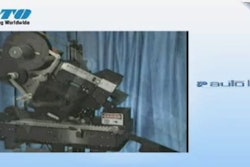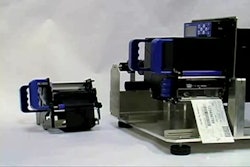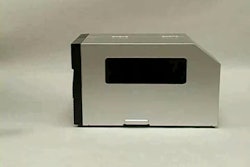Along with key vendor representatives for the implementation, Lee Mar,
Lexar Media's senior logistics analyst and RFID project lead, discussed
the company’s RFID program in a late March Webinar. In it he also
passed along some advice.
That story, "Lexar leverages RFID," is told
in the upcoming May issue of Packaging World. Unfortunately, there
wasn't enough space for the best practices advice from the participants
in that article, but this article should rectify that for those
interested in reading more about what they learned.
Background:
Lexar Media, Fremont, CA, which has been involved in RFID for the past
three years, is a supplier of flash products to retailers such as
Wal-Mart, Target, Best Buy, and OfficeMax, Lexar produces more than 200
different stockkeeping units and 30,000 monthly shipments, 4,000 of
which are sent to Wal-Mart. Products are shipped as individual cases or
as pallet loads.
“We wanted to work our way up as experience was gained and as
technology was improved,” says Mar. The company has gone from using
200,000 RFID tags a year to currently using more than 1 million RFID
tags/yr today. The implementation is at the company's third-party
logistics provider.
In 2007, as part of its scale-up strategy, Lexar began Phase 3 of its
RFID implementation using portable RFID readers. The compact units have
been initially deployed onto forklift trucks as mobile readers. The
forklift reader interrogates a pallet and verifies that it is
associated with a particular order.
"We were able to automated and expand the verification process to
ensure that forklift operators are not only selecting the right pallet,
but also placing that pallet on the right truck," said Mar. "This
marriage of RFID with mobility enabled us to easily move our RFID
readers as needed, all with our existing infrastructure."
Mar shared one key bit of advice. "Choose your vendors wisely, ones
that can grow as you learn, and are flexible enough to help optimize
your process as you come to learn what RFID can do for you," he said.
Lexar found that through its RFID software solution vendor, KeyTone
Technologies, and Motorola,
which provides its mobile readers for flexibility. Motorola's RD5000
readers permit wireless communication via integrated 802.11a/b/g WLAN
radio and Bluetooth communication.
This solution also enables Lexar to scale up and down to meet fluctuating seasonal demands.
Suppliers' insights
Edwin Winder, executive vice president of KeyTone Technologies, offered the following advice based on his experience:
* Choose a software platform that is flexible
* Choose a solution that adapts to your processes
* Employ a solution that complements your existing applications
* Select a solution that is low maintenance
* Ensure that the physics, process, and systems work in concert
"Implementing is not the answer," said Winder. "Implementing RFID
successfully and then using it in order to change as you go forward is
the best practice."
Joe White, Motorola's vice president of RFID business development and
marketing, shared a number of trends he's seeing unfold in RFID
applications in 2008. These include applications that are focusing on
entry and exit "choke" points, as Lexar did by bringing visibility to
its dock doors via the mobile RFID readers.
While White is a proponent of mobile RFID, he is not promoting elimination of fixed read points.
"[Supplement those] with mobile touch points throughout the operation
to enhance visibility," he said. "Mobile RFID can play a role in the
warehouse environment all the way from pallet jacks to shrink-wrap
equipment," and to outbound shipments loading at dock doors as at Lexar.
Motorola's read on RFID trends
For those who follow RFID closely, it's worth sharing some of the trends White also noted:
* Continued healthy, steady growth in RFID implementations. "It’s not
the explosion around the supply chain, but 20-percent yearly growth,"
said White. "That compares to other data-capture technology growth that
is around six percent"
* Customer mindsets are changing from "How does Gen 2 technology work?”
to "How are we going to deploy, and how are we going to scale within
our installations?"
* Companies looking at supply-chain visibility are now looking at
product traceability, especially around retail perishables and
pharmaceuticals. "Inherent characteristics of that [pharma] market
makes it particularly beneficial to get that visibility. Time-to-market
is a differentiator of how good a product you are selling in the
marketplace and how long that product lasts when it reaches the
customer, in order to deliver to the customer the best product," said
White.
* Customers are looking beyond UHF RFID and are integrating their RFID
with their overall RF strategy, with technologies such as near-field
communications and Wi-Fi.
* Awareness around mandates has created a lot of activity within four
walls, and companies are shifting from open to closed-loop
implementations where customers could easily identify the payback and
deploy successfully.
* Lastly, White noted to expect Motorola to introduce a suite of
different form factor products over the next year, in applications
where its customers are seeing the biggest benefits today.
Lexar Media RFID best practices
A recent Webinar on Lexar Media's RFID implementation yielded advice and best practices from the end user and vendors involved.
Apr 24, 2008
Machinery Basics
Annual Outlook Report: Automation & Robotics
What's in store for CPGs in 2025 and beyond? Packaging World editors explore the survey responses from 118 brand owners, CPG, and FMCG Packaging World readers for its new Annual Outlook Report.
Download
List: Digitalization Companies From PACK EXPO
Looking for CPG-focused digital transformation solutions? Download our editor-curated list from PACK EXPO featuring top companies offering warehouse management, ERP, digital twin, and MES software with supply chain visibility and analytics capabilities—all tailored specifically for CPG operations.
Download Now
Downloads






















